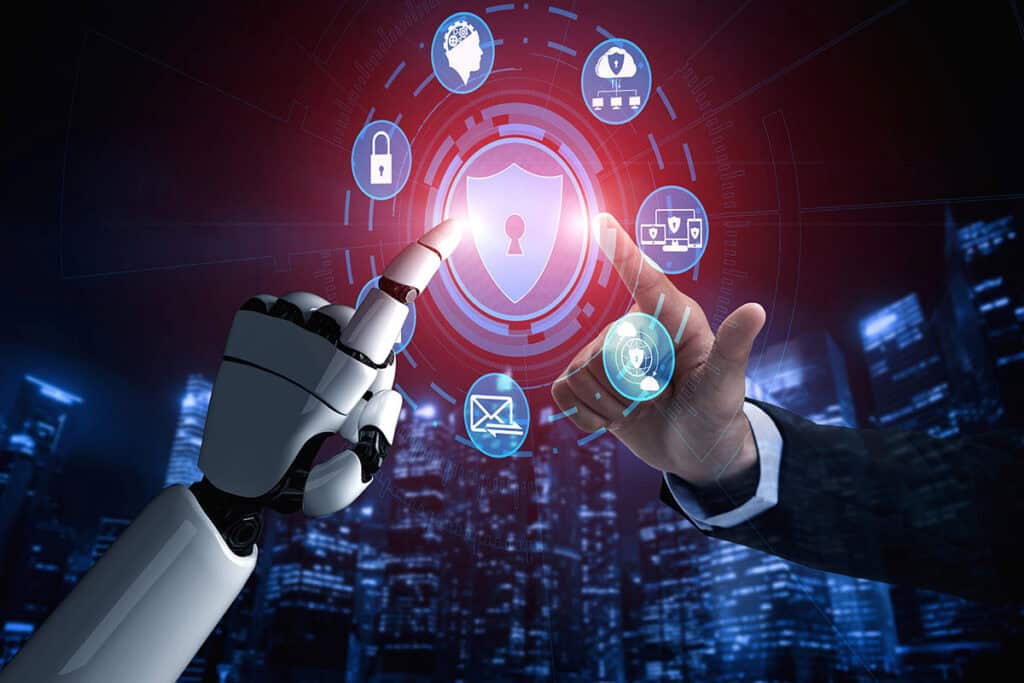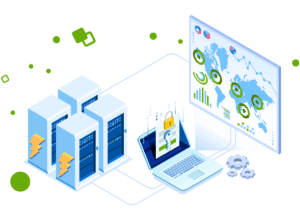How To Implement AI & IT Automation: Is It the Key to Staying Ahead?

AI & IT Automation have become essential in the modern market. Organizations use these technologies to improve efficiency, simplify processes, and encourage innovation. Here’s what you need to know:
- AI: Helps businesses make decisions by analyzing large amounts of data, allowing them to quickly adapt to market changes.
- IT Automation: Focuses on automating repetitive tasks, freeing up human resources for more strategic initiatives.
To stay competitive, businesses must prioritize AI-driven automation as part of their transformation efforts. By adopting these technologies, companies can boost productivity and promote sustainable growth. In a world where industries are constantly changing, innovation is key. This means organizations need to make automation strategies a priority for long-term success.
Understanding AI and IT Automation
Artificial intelligence (AI) and IT automation are critical components transforming modern businesses.
Clarification of These Concepts
- Artificial Intelligence: Refers to systems capable of performing tasks that typically require human intelligence. This includes problem-solving, learning from data, and making decisions.
- IT Automation: Involves using technology to perform tasks with minimal human intervention, streamlining processes to enhance operational efficiency.
Traditional vs. AI-Enhanced Approaches
Traditional automation focuses on predefined workflows, executing repetitive tasks without adaptability. In contrast, AI-enhanced approaches leverage machine learning algorithms, enabling systems to learn from data trends and adapt over time.
Business Automation Advantages
- Increased efficiency through reduced manual labor
- Enhanced accuracy by minimizing human error
- Real-time decision-making capabilities driven by data analysis
Benefits of AI & IT Automation
- Increased Efficiency: Automating routine tasks frees up valuable time for employees to focus on higher-value activities. This leads to streamlined operations and faster project completion.
- Cost Savings: By reducing manual labor and minimizing errors, AI & IT automation can substantially lower operational costs. Organizations can reallocate resources more effectively, leading to improved profitability.
- Enhanced Decision-Making: AI tools analyze vast amounts of data quickly, providing insights that support strategic decision-making. Real-time analytics empower businesses to adapt their strategies based on market trends and customer behavior.
- Improved Customer Experience: Automation enhances customer interactions through personalized communication and timely responses. AI-driven chatbots and recommendation systems ensure customers receive relevant information and support.
- Scalability: As businesses grow, automation facilitates the scaling of operations without a proportional increase in costs or workforce size. This adaptability is vital in competitive markets.
Enhancing Human-Machine Collaboration with AI & IT Automation
Within workplaces, the synergy between humans and machines is reshaping how tasks are performed. This collaboration enhances productivity and fosters innovation.
Below are a few key aspects of human-machine collaboration:
- Complementary Strengths: Machines excel in processing data quickly and performing repetitive tasks, while employees bring creativity, critical thinking, and emotional intelligence to the table. Combining these strengths leads to more effective outcomes.
- Decision Support: AI systems analyze vast amounts of data to deliver insights that inform decision-making. Employees can interpret these insights within the context of their expertise, ensuring decisions align with organizational goals.
- Adaptability: As workplace demands evolve, human-machine collaboration allows for rapid adjustments. Teams can leverage AI tools to streamline processes, enabling them to focus on strategic initiatives rather than mundane tasks.
- Innovation Catalyst: The integration of AI into workflows encourages teams to explore new ways of working. With machines handling routine operations, employees have more time to innovate and develop creative solutions.
Emphasizing this partnership not only enhances operational efficiency but also cultivates a culture of continuous improvement. Organizations that prioritize human-machine collaboration position themselves for long-term success.
The Importance of Continuous Learning and Upskilling in an Automated World
Continuous learning initiatives are crucial for employees. As technology advances, the skills needed to navigate automated environments effectively also change.
Why Ongoing Learning Matters
Here are some key reasons why continuous learning is important:
- Adaptation to Change: Employees must be flexible and ready to embrace new tools and processes that automation brings.
- Skill Relevance: Regular training ensures that skills match current industry needs, reducing the risk of becoming outdated.
Platforms for Professional Growth
Training programs offer valuable opportunities for career advancement. Here are some notable platforms that provide relevant courses:
- LinkedIn Learning: Offers a wide range of courses focusing on automation technologies, data analysis, and soft skills essential for collaboration in automated settings.
- Coursera: Partners with top universities and organizations to provide certifications in AI applications, machine learning, and project management.
Implementing AI Automation Effectively: A Practical Guide for Businesses
The journey toward effective AI automation begins with identifying potential areas within your organization that can benefit from automation. Consider the following steps:
- Assess Current Processes: Evaluate existing workflows to pinpoint repetitive tasks that consume valuable time and resources.
- Engage Employees: Involve team members in discussions about pain points, as they often have insights into inefficiencies that could be streamlined.
- Define Objectives: Establish clear goals for automation, such as reducing costs, improving accuracy, or enhancing customer service.
Selecting suitable AI tools is crucial in this phase. Consider these options:
- Salesforce Einstein: An AI-powered CRM that enhances customer relationships through data-driven insights.
- UiPath: This Robotic Process Automation tool enables businesses to automate routine tasks, freeing up human resources for more strategic functions.
Strategic AI implementation requires careful planning and integration of automation tools into existing systems. This ensures a seamless transition and maximizes the benefits of AI-driven processes. Prioritizing the right tools and understanding organizational needs will lay the groundwork for successful automation initiatives.
Anticipating Future Trends in AI and Automation
Emerging trends in AI and automation are reshaping business landscapes. Hyperautomation stands out as a key development, integrating various technologies like Artificial Intelligence (AI), Machine Learning (ML), and Robotic Process Automation (RPA). This convergence enables businesses to automate complex processes, enhance operational efficiency, and improve decision-making capabilities.
These are a few aspects of hyperautomation:
- Integration of Technologies: Seamlessly combines AI, ML, and RPA for comprehensive automation solutions.
- Enhanced Decision Intelligence: Leverages data analytics and predictive modeling to facilitate informed strategic planning.
- Scalability: Allows organizations to scale operations rapidly while maintaining control over processes.
As companies adopt hyperautomation, they can expect significant benefits including:
- Increased Efficiency: Streamlined processes reduce manual tasks and errors.
- Cost Reduction: Minimizes operational costs by automating repetitive functions.
- Improved Agility: Organizations can adapt quickly to market changes through automated insights.
Businesses that embrace these trends position themselves advantageously for future challenges. Understanding the evolution of decision intelligence will be crucial for making informed investments in technology.
Embracing Change with AI & IT Automation
The landscape of many workplaces is developing rapidly, driven by technological advancements. Companies must be proactive in adopting these changes to stay relevant.
Here are some key strategies:
- Innovation Focus: Encourage a culture that embraces innovation. Foster environments where experimentation with new technologies is welcomed.
- Adaptability: Promote adaptability among employees. Encourage them to view change as an opportunity for growth rather than a challenge.
- Collaboration: Leverage collaboration between humans and machines. This synergy can lead to improved processes and enhanced decision-making.
- Continuous Learning: Invest in ongoing training programs. Equip your workforce with the skills necessary to navigate an automated world effectively.
By embracing these principles, organizations can not only survive but thrive in the face of change, positioning themselves as leaders in their respective industries.
Frequently Asked Questions About IT Automation
What is AI and IT automation in the business context?
AI and IT automation refer to the integration of artificial intelligence technologies with traditional automation processes to enhance business operations. This combination enables organizations to improve efficiency, reduce costs, and maintain a competitive edge by automating repetitive tasks and leveraging data-driven insights.
How does AI-enhanced automation differ from traditional automation?
Traditional automation typically involves predefined, rule-based processes that execute repetitive tasks without the ability to learn or adapt. In contrast, AI-enhanced automation incorporates machine learning and intelligent algorithms, allowing systems to analyze data, make decisions, and improve over time based on new information.
What are the key benefits of implementing AI & IT automation in businesses?
The key benefits of AI & IT automation for businesses include increased operational efficiency, significant cost savings through reduced labor requirements, enhanced decision-making capabilities powered by real-time data analysis, and improved customer experiences through personalized interactions.
How can businesses enhance human-machine collaboration with AI & IT automation?
Businesses can enhance human-machine collaboration by integrating AI tools that support human expertise rather than replace it. This involves creating workflows where employees utilize technology for complex problem-solving while machines handle routine tasks, fostering innovation and productivity in the workplace.
Why is continuous learning important in an automated work environment?
Continuous learning is crucial in an automated work environment as it helps employees adapt to rapidly changing technologies and processes. Ongoing training initiatives ensure that staff remain proficient in using new tools and methodologies, enhancing their skill sets through platforms like LinkedIn Learning and Coursera.







